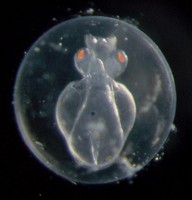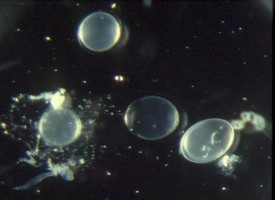Enoploteuthidae
Kotaro Tsuchiya and Richard E. Young- Enoploteuthis Orbigny in Rüppell 1844
- Abralia Gray 1849
- Abraliopsis Joubin 1896
- Watasenia Ishikawa 1914
Introduction
Enoploteuthid squid are small, between 3 and 13 cm in mantle length. All open-ocean species occupy upper mesopelagic waters during the day. In the regions where the mesopelagic zone intersects the slopes of land masses (i.e., the mesopelagic boundary zone) some species may occur at shallower depths. Many species are known to undergo extensive daily vertical migrations which may be characteristic of all species in the family. The species are noted for their colorful array of numerous photophores distributed primarily over the ventral surfaces of the head, arms, funnel and mantle.


Figure. Ventral view of a bioluminescing Watasenia scintillans, Sea of Japan. Photograph by Danté Fenolio
Brief diagnosis:
A member of the enoploteuthid families ...
- with hooks (as well as suckers) on arms and tentacles.
- without photophores on tentacles or viscera but with photophores on eyeball.
- with numerous, small integumental photophores.
Characteristics
From Young, et al., 1998.- Tentacles
- Armature on club manus in two or three series including one or two series of hooks.
- Armature on club manus in two or three series including one or two series of hooks.
- Arms
- Hooks, in two series, present on all arms; suckers present on all arm tips except arms IV in Abraliopsis and Watasenia.
- Hooks, in two series, present on all arms; suckers present on all arm tips except arms IV in Abraliopsis and Watasenia.
- Photophores
- Numerous, small integumental photophores on mantle, funnel, head and arms.
- Photophores absent from tentacles, viscera and, usually, fins.
- Eyeball with photophores in single line; anterior and posterior-most photophores generally largest.
- Tail
- Tail broad and extends well beyond conus of gladius.
- Tail tissue with numerous vesicles.
- Viscera
- Nidamental glands absent.
Comments
The following table compares characteristics of subadults for the genera of Enoploteuthidae.
| Enoploteuthis | Abralia | Abraliopsis | Watasenia | |
| Thick tail extends beyond posterior end of fins | Yes | No | No | No |
| Number of hook series on tentacular clubs | 2 | 1 | 2 | 1 |
| Tips of arms IV with large, spherical photophores covered with black chromatophores | No | No | Yes | Yes |
| Hectocotylus | Right arm IV | Left or Right arm IV | Right arm IV | Right arm IV |
| Arms with distal suckers | Arms I-IV | Arms I-IV | Arms I-III | Arms I-III |
| Pigmentation of oral surface of buccal membrane | Primarily in chromatophores | In chromatophores | In epithelium | In epithelium |
| Habitat | Tropical/temperate waters world wide | Tropical/temperate waters world wide | Tropical/temperate waters world wide | Temperate waters of Northwest Pacific |
Nomenclature
A list of all nominal genera and species in the Enoploteuthidae can be found here. The list includes the current status and type species of all genera, and the current status, type repository and type locality of all species and all pertinent references.
Discussion of Phylogenetic Relationships
Young and Bennett (1988) found strong similarities in photophore structure between Watasenia and Abraliopsis and between Abralia and Enoploteuthis. They did not, however, distinguish between plesiomorphic and apomorphic characters. Relationships, therefore, remain uncertain although the similarity between Watasenia and Abraliopsis is supported by the shared presence of several other characters (see respective pages).
Life history
Members of the family lack nidamental glands but have enlarged oviducal glands. Spawning females produce long gelatinous strings with eggs embedded in a single series. The eggs are about 1 mm long and oval to spherical in shape, depending on the species. Developing embryos are often found in plankton tows taken in tropical near-surface waters. The enoploteuthid eggs in the photo on the left, taken from a plankton tow, consist of two Abralia trigonura on the left (one with its jelly layer still somewhat intact), probably Abraliopsis sp. in the center and Enoploteuthis reticulata on the right. The latter is distinctive in having a pitted chorion which scatters the light giving a less transparent appearance.



Figure. The advanced embryo on the left (photograph enlarged relative to that of the eggs on the right) shows the large internal yolk sac and a central black dot which is the developing ink sac. Enoploteuthid paralarvae are often the most abundant young cephalopods found in the near-surface plankton of tropical and subtropical seas (Young and Harman, 1985). Enoploteuthid eggs, off Hawaii. Abraliopsis sp. embryo, off Hawaii. Copyright © 1996, R. E. Young.
References
Young, R. E. and T. M. Bennett. 1988. Photophore structure and evolution within the Enoploteuthidae (Cephalopoda). P. 241-251. In: M. R. Clarke and E. R. Trueman (Eds.). The Mollusca. Vol. 12 Paleontology and Neotology of Cephalopods. Academic Press, N.Y., 355pp.
Young, R. E. and R. Harman. 1985. Early life history stages of enoploteuthin squid (Cephalopoda: Teuthoidea: Enoploteuthidae) from Hawaiian waters. Vie Milieu 35: 181-201.
Young, R. E., L. A. Burgess, C. F. E. Roper, M. J. Sweeney and S. J. Stephen. 1998. Classification of the Enoploteuthidae, Pyroteuthidae and Ancistrocheiridae. Smithson. Contr. Zool., 586: 239-256.
Title Illustrations

| Scientific Name | Abralia trigonura |
|---|---|
| Location | Off Kona coast of Hawaii Island |
| Specimen Condition | Live Specimen |
| Identified By | R. E. Young |
| Behavior | Squid swimming close to ocean floor at night at a depth of about 25 m, attracted by photographer's lights. |
| Sex | Female |
| Size | 30- 40 mm ML (guess) |
| Copyright | © 2017 Jeffrey Milisen |
About This Page

Tokyo University of Fisheries, Tokyo, Japan

University of Hawaii, Honolulu, HI, USA
Correspondence regarding this page should be directed to Kotaro Tsuchiya at
Page copyright © 2019 and
All Rights Reserved.
- Content changed 29 March 2018
Citing this page:
Tsuchiya, Kotaro and Richard E. Young. 2018. Enoploteuthidae . Version 29 March 2018. http://tolweb.org/Enoploteuthidae/19634/2018.03.29 in The Tree of Life Web Project, http://tolweb.org/









 Go to quick links
Go to quick search
Go to navigation for this section of the ToL site
Go to detailed links for the ToL site
Go to quick links
Go to quick search
Go to navigation for this section of the ToL site
Go to detailed links for the ToL site